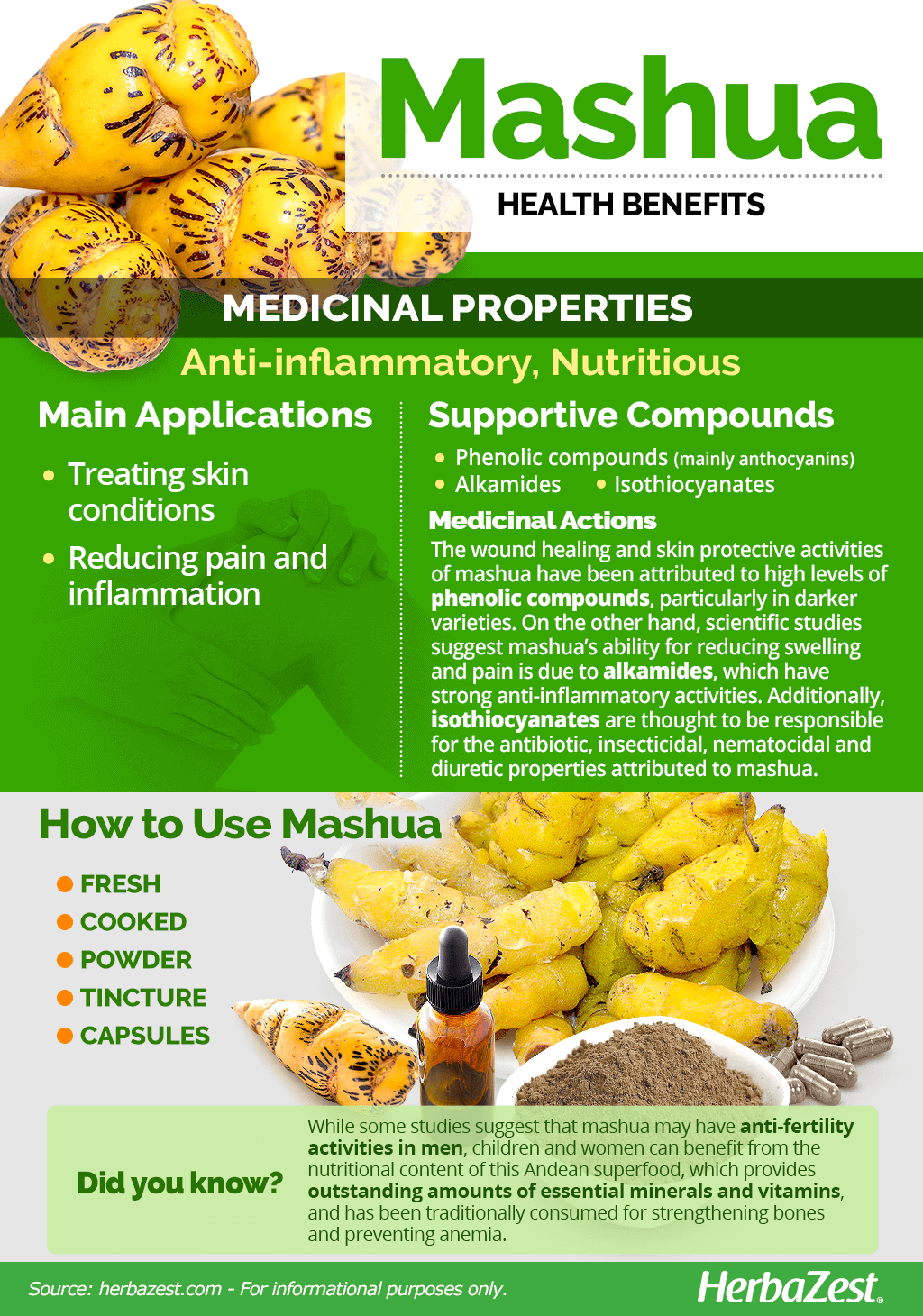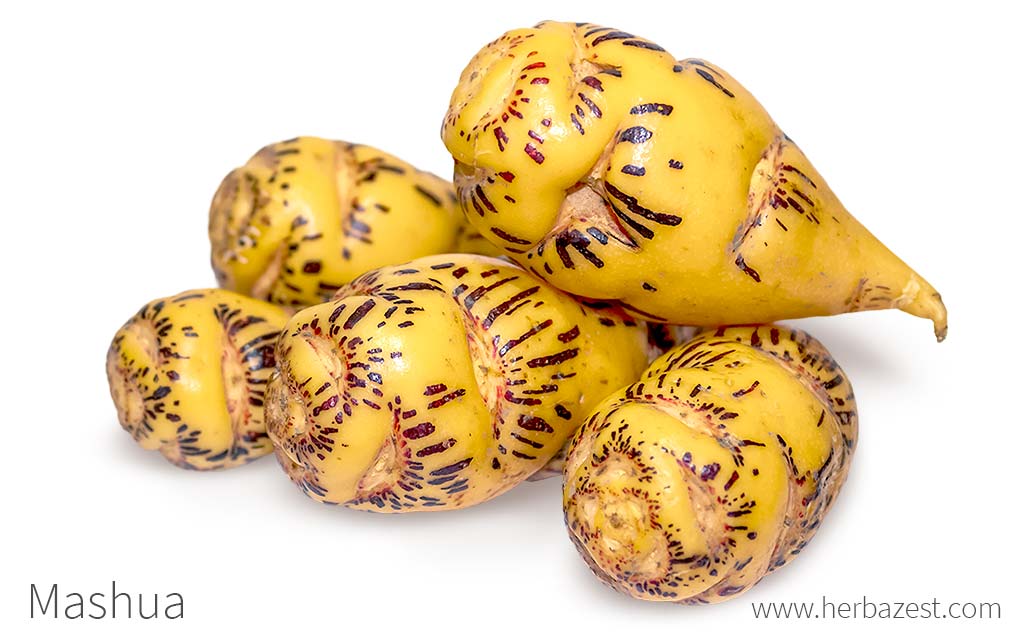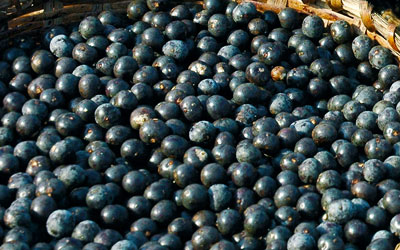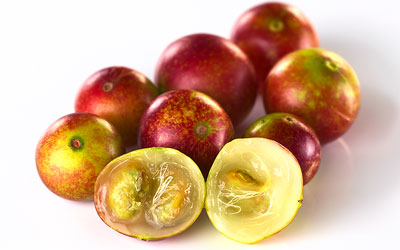Mashua, also known as anu and cubio, is a tuberous plant native to the highlands of South America, from Colombia to northwest Argentina, including Ecuador, Bolivia, and Peru. It has a long history of use for both medicinal and nutritional purposes. Modern medicine has just began to explore and understand the health benefits of mashua as well as its potential as a superfood.
Mashua Medicinal Properties
Health Benefits of Mashua
Mashua is an Andean species that is fairly new to science and international food trade. However, some of its popular uses are being investigated with promising results.
Scientific research suggests that the most important health benefits of mashua are:
Treating skin conditions. The antioxidant and antibacterial properties of mashua have been traditionally used for the topical relief of skin rashes and superficial wounds.
Reducing pain and inflammations. Mashua has been shown to have strong analgesic and anti-inflammatory compounds, which have been used to treat internal and external inflammatory conditions for centuries.
Other traditional applications involving the whole mashua plant (leaves, flowers, and tuberous roots) include the treatment of sexually transmitted diseases, pulmonary and kidney problems, and parasitic infestations.
How It Works
Until recently, mashua's properties and mechanisms of action were a mystery; however, recent investigations have shed light on the great potential of this Andean species for treating a number of conditions.
The wound healing and skin protecting activities of mashua have been known by folk medicine for centuries. Modern science attribute them to high levels of phenolic compounds, particularly in darker varieties, which have been shown to have at least 11 different anthocyanins, making this Andean tuber a promising agent for treating a variety of dermatological problems.1,2
The traditional topical uses of mashua to reduce swelling and pain have been validated by scientific studies, which have isolated two alkamides (fatty acid amides produced by some plants) with strong anti-inflammatory activities. The presence of these compounds is stronger in purple and black mashua tubers.3,4
Additionally, isothiocyanates are thought to be responsible for the antibiotic, insecticidal, nematocidal, and diuretic properties attributed to mashua and traditionally used in folk medicine.
Other herbs with anti-inflammatory benefits are aloe, arrowroot, and greater plantain.
Side Effects of Mashua
Mashua is considered generally safe to be consumed in moderate amounts. However, it should be noted that both mashua tubers and leaves have shown anti-fertility activities in men, negatively affecting spermatogenesis and testicular function. The culprit is a major secondary metabolite of mashua, called p-methoxybenzylglucosinolate.5,6 Due to these undesirable effects, couples trying to conceive would be better off avoiding this Andean tuber in both culinary and medicinal forms.
Additionally, preliminary findings suggest that mashua's isothiocyanates exert inhibitory actions over estradiol binding, which suggests estrogenic properties. While they may benefit women with estrogen deficiency, they're not recommended for those who are pregnant or breastfeeding, nor for women with a history of breast cancer.7,8
- Medicinal action Anti-inflammatory, Nutritious
- Key constituents Phenolic compounds, alkamides, isothiocyanates
- Ways to use Capsules, Food, Freshly ground, Tincture, Powder
- Medicinal rating (2) Minorly useful plant
- Safety ranking Use with caution

Mashua Nutrition
The outstanding nutritional value of mashua tubers, regardless of their color, put them in the super foods category. While all mashua types contain protein, dietary fiber, and carbohydrates in small amounts, this Andean tuber is a powerhouse of key minerals and vitamins.
The mind-blowing amounts of key minerals in mashua tubers validate its tradicional status of staple food in Andean communities. Calcium is absolutely necesary in the human diet, not only for building strong bones, but also for optimal nervous function. People who lacks calcium in their diet often suffer from muscle and nerves spams. The importance of having an adequate intake of this essential mineral in every stage of the human life can't be overstated. Iron, on the other hand, is crucial for the formation of new red blood cells and its deficiency leads to anemia due to low hemoglobin levels. Additionally, phosphorus is essential for all living creatures; it is contained in every cell of the body, but particularly in bones and teeth, and it is also crucial for energy metabolism.
For proper absorption of calcium and iron, vitamin C (ascorbic acid) is absolutely necessary, and mashua tubers offer impressive amounts of this water soluble antioxidant, which is not only key for a healthy and youthful skin, since it promotes collagen production, but also prevents degenerative diseases by protecting cellular integrity. Finally, there are two B vitamins whose levels are totally off the charts in mashua tubers: vitamin B1 (thiamin), and vitamin B2 (riboflavin), both water soluble and instrumental for energy production and fat metabolism. They make possible daily bodily functions, and their deficiency can lead to various health problems, such as migrains, cardiovascular diseases, and even cognitive decline.
100 grams of mashua provide 52 calories, with 4%DV of carbohydrates as well as 3%DV of proteins and dietary fiber, respectively.
As a novel superfood, mashua tubers are part of an exclusive list of highly nutritious and medicinal crops from South America, including amaranth, kaniwa, maca, quinoa, and sacha inchi.
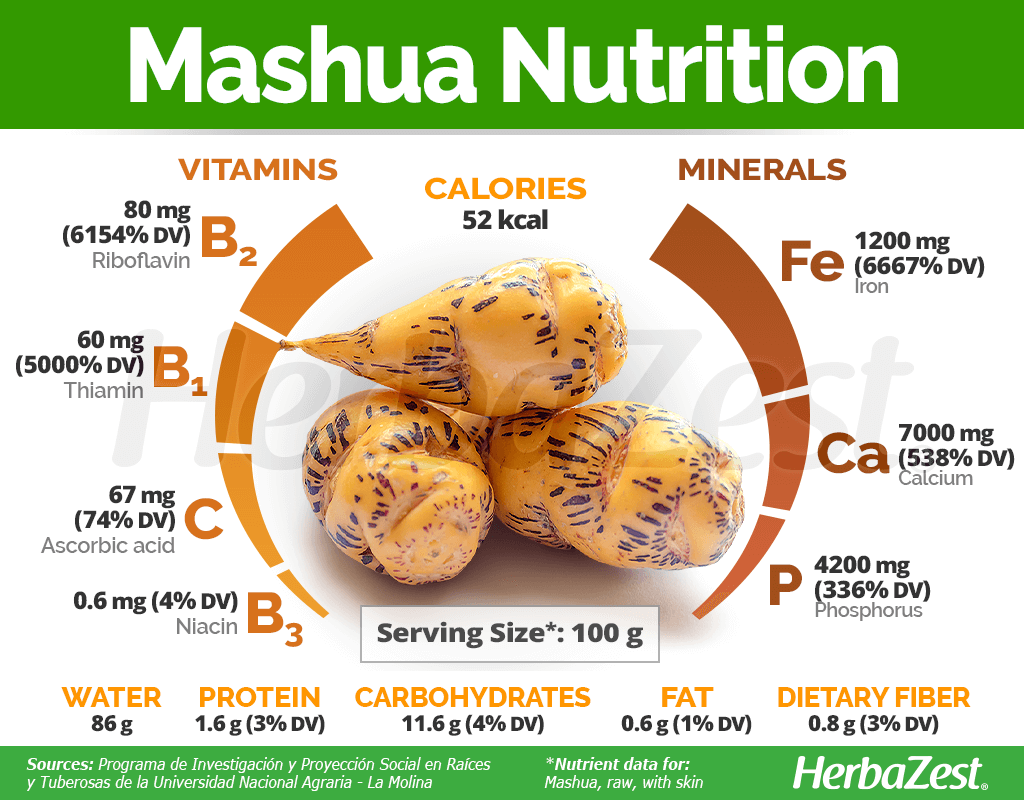
How to Consume Mashua
All parts of mashua are edible, including leaves, flowers, and tubers, which are typically consumed in culinary forms. Some medicinal and supplemental forms of mashua are also available.
Natural Forms
Fresh. Raw mashua's taste is peppery and pungent, comparable to horseradish. The tubers can be grated and added to salads, along with mashua's flowers and leaves, whose taste resembles that of mustard greens.
Cooked. Mashua tubers are usually boiled or roasted. During the cooking process, they acquire a mushy texture and an aromatic, anise-like taste, also providing decent nutritional benefits.
Powder. Offering a longer shelf-life, mashua powder, or flour, can be used in porridges, baking, pancakes, and more, providing not only valuable nutrients, but also dietary fiber and anti-inflammatory compounds.
Herbal Remedies & Supplements
Tincture. Mashua tincture concentrates the anti-inflammatory properties of the herb, and it is often used as a testosterone inhibitor and a remedy for benign prostatic hyperplasia (BPH); however, further research is necessary to validate these applications.
Capsules. Mashua capsules are marketed as a natural diuretic and a natural relief for prostatic inflammation. Usually made of black or purple varieties of mashua, this supplemental form also provides a good deal of antioxidants in the form of anthocyanins.
Men should be aware that excessive consumption of mashua tubers as well as mashua in medicinal doses may lead to low libido and reduced fertility.
- Edible parts Flowers, Leaves, Root
- Taste Aromatic
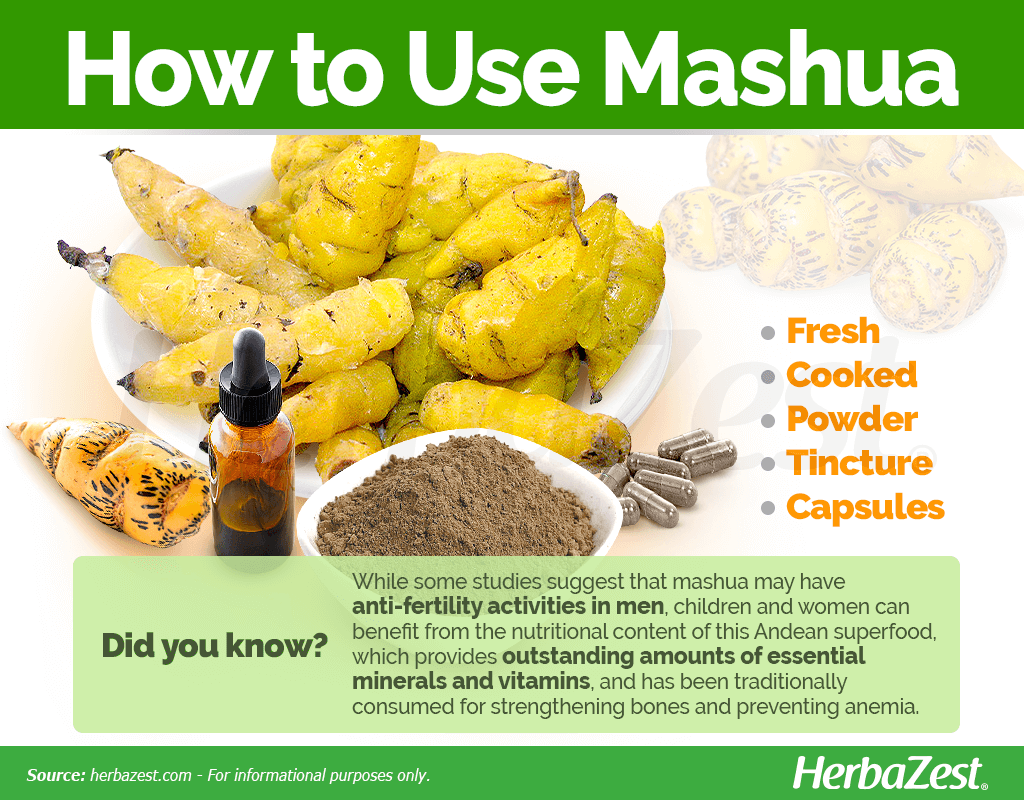
Growing
Mashua is a type of climbing nasturtium, which makes it great as a wall cover for gardens. However, this species is native to the Andes, and there are only a few regions suitable for its cultivation. Mashua is cultivated as a perennial, mostly for ornamental purposes, along the Pacific Northwest, from Great Britain to Oregon, and it has been successfully introduced in New Zealand, alongside other Andean crops. For gardeners living in areas with the right soil, temperature, and humidity, growing mashua should not be a problem.
Growing Guidelines
Mashua is traditionally cultivated in the highlands of South America, 8,530 - 13,123 feet (2,600 - 4,000 meters) above the sea level. However, a suitable environment outside of its native lands are the coastal areas of North America, with short-light days and cool temperatures of 20°F (-7°C) throughout the cold months, and 80°F (27°C) during the summer.
Typically propagated using selected tubers, which are planted 16-20 inches (40-50 cm) apart, the hardy mashua plant can thrive even in poor soils, but a light, sandy soil is ideal for its cultivation. In a similar fashion as potatoes, the tubers should be planted in spring to be harvested in autumn.
The mashua plant can be grown as an annual, in which case tubers must be harvested in October, or as a perennial, for ornamental purposes, to enjoy its pretty flowers from August to the first frost.
It should be noticed that mashua is an aggressive climber that can take over a garden if left unattended. For this reason, regular pruning is advised.
Thanks to its insecticidal compounds, the mashua plant is virtually free of pests and diseases. However, it is vulnerable to viruses, such as Tropaeolum mosaic potyvirus, which can stunt the plant and affect its productivity.
- Life cycle Perennial
- Harvested parts Flowers, Roots, Leaves
- Light requirements Morning sun with afternoon shade
- Soil Light (sandy), Well-drained
- Growing habitat Andean region
- USDA Plant Hardiness Zones 7a, 7b, 8a, 8b, 9a
- Planting time Spring
- Plant spacing average 0.1 m (0.30 ft)
- Potential diseases Viruses
Additional Information
Plant Biology
Mashua is a perennial herbaceous plant that can be cultivated as a cold-tolerant anual crop for alimentary purposes, or as a perennial for ornamental use. This Andean tuber is known as cubio in Colombia, mashua in Perú and Ecuador, and isaño or añu (anu) in Bolivia.
The mashua plant is characterized by delicate, cylindrical stems that can cover a perimeter of 3.28-4.9 feet (1-1.5 m), and grow up to 19.6-31.5 inches (50-80 cm) if grown for harvest. However, if cultivated as an ornamental, it can climb 7-13 feet (2-4 m) in height. Mashua stems have tactile petioles that allow them to get attached to other plants or different kinds of supports. Three to five lobed leaves grow from each stem. Mashua flowers have long stalks and are solitary, axial, and bisexual, in colors that range from dark yellow and orange to scarlet. Mashua tubers have a carrot-like shape, conical or oblong, with a length of 2-6 inches (5-15 cm), and a diameter of 1-2 hinches (3-6 cm), and come in a wide range of colors, including orange, pale yellow, orange yellowish, yellow, purple grayish, dark purple, and red grayish.
Classification
Mashua (Tropaeolum tuberosum) is a member of the Tropaeolaceae family, represented by only one genus, Tropaeolum, which comprisses about 80 species of perennial plants with flowers, including the common garden nasturtium (Tropaeolum majus).
Varieties of mashua
Over 100 mashua varieties have been registered in the Andean countries that cultivate this tuber. Most of them are classified by their color. It is worth to mention that, being an underappreciated crop, the genetic diversity of mashua has suffered a reduction over time.
Historical Information
According to archeological findings, mashua has been part of the Andean diet for centuries, along with other high-altitude crops. Geographically, the origin of mashua is thought to be near to Titicaca lake, somewhere between modern Peru and Bolivia. Mashua leaves, flowers, and tubers have been found depicted on pre-Columbian pottery and textiles, as a testimony to how valuable this crop was to the ancient inhabitants of the Andes.
More recently, in the late 20th century, some countries, like Canada, United States of America, and New Zealand, developed an interest in Andean crops due to their high nutritional value, hardiness, and resistance to plagues.
Economic Data
Due to recent scientific findings categorizing mashua as a new functional superfood, the cultivation of this underrated tuber has experienced a small increase, mainly in its native lands. Peru leads the production of mashua, with 41,000 tons harvested during the period 2018-2019. However, most of it still goes to local markets. The same happens in other Andean countries, like Bolivia, Colombia, and Ecuador.
Other Uses
Gardening. Due to its beautiful flowers and nice, compact foliage, similar to nasturtium, mashua is also cultivated as an ornamental.
Fodder. In its native highlands, mashua leaves, flowers, and even tubers are used to feed farm animals.
- Other uses Animal feed
Sources
- Agroindustrial Science, Mashua (tropaeolum tuberosum): Composición nutricional, características químicas, compuestos bioactivos y propiedades beneficiosas para la salud, 2022
- Antioxidants (Basel), Anthocyanin-Related Pigments: Natural Allies for Skin Health Maintenance and Protection. 2021
- Encyclopedia of Food Sciences and Nutrition (Second Edition), VEGETABLES OF TROPICAL CLIMATES | Root Crops of Uplands| Mashua, 2003
- Foods, Assessing the Nutritional Value of Root and Tuber Crops from Bolivia and Peru, 2019
- International Journal of Food Science, Characterization of Nutritional and Bioactive Compound in Three Genotypes of Mashua (Tropaeolum tuberosum Ruiz and Pavón) from Different Agroecological Areas in Puno, 2022
- Lost Crops of the Incas: Little-Known Plants of the Andes with Promise for Worldwide Cultivation
- Ministerio de Desarrollo Agrario y Riego del Perú, Guía de manejo agronomico de mashua para conservación ex situ
- Oregon State University, Six exotic vegetables for Oregon gardeners to try
- Promoting the Conservation and Use of Underutilized and Neglected Crops, Mashua
- Southern Illinois University, Mashua
- Starchy Crops Morphology, Extraction, Properties and Applications, Origin, domestication, and evolution of underground starchy crops of South America, 2023
- Journal of Ethnopharmacology, Local/traditional uses, secondary metabolites and biological activities of Mashua (Tropaeolum tuberosum Ruíz & Pavón), 2020 | Anti-reproductive and other medicinal effects of Tropaeolum tuberosum, 1982
- Advances in Food and Nutrition Research, Bioactive Potential of Andean Fruits, Seeds, and Tubers, 2018
Footnotes:
- Journal of Agricultural and Food Chemistry. (2006). High-performance liquid chromatography with photodiode array detection (HPLC-DAD)/HPLC-mass spectrometry (MS) profiling of anthocyanins from Andean Mashua Tubers (Tropaeolum tuberosum Ruíz and Pavón) and their contribution to the overall antioxidant activity. Retrieved September 12, 2023, from: https://pubmed.ncbi.nlm.nih.gov/16968067/
- Veterinary World. (2022). Wound healing activity of Tropaeolum tuberosum-based topical formulations in mice. Retrieved September 12, 2023, from: https://www.ncbi.nlm.nih.gov/pmc/articles/PMC8980398/
- Natural Product Research. (2022). Anti-glycative and anti-inflammatory effects of macamides isolated from Tropaeolum tuberosum in skin cells. Retrieved September 12, 2023, from: https://pubmed.ncbi.nlm.nih.gov/34935571/
- Journal of Ethnopharmacology. (2019). Alkamides from Tropaeolum tuberosum inhibit inflammatory response induced by TNF-α and NF-κB. Retrieved September 12, 2023, from: https://pubmed.ncbi.nlm.nih.gov/30753883/
- JBRA Asissted Reproduction. (2018). Toxic effect of Tropaeolum majus L. leaves on spermatogenesis in mice. Retrieved September 12, 2023, from: https://www.ncbi.nlm.nih.gov/pmc/articles/PMC6106639/
- Andrologia. (2008). Tropaeolum tuberosum (Mashua) reduces testicular function: effect of different treatment times. Retrieved September 12, 2023, from: https://pubmed.ncbi.nlm.nih.gov/19032684/
- Jornal of Ethnopharmacology. (1982). Anti-reproductive and other medicinal effects of Tropaeolum tuberosum. Retrieved September 12, 2023, from: https://pubmed.ncbi.nlm.nih.gov/7057655/
- The Harvard Gazette. (2023). Estrogen a more powerful breast cancer culprit than we realized. Retrieved September 22, 2023, from: https://news.harvard.edu/gazette/story/2023/05/estrogen-a-more-powerful-breast-cancer-culprit-than-we-realized/
